It’s an early morning for us, lol. We are up at 5:30 am to catch the Peru Hop, a “hop on hop off” bus that will take us down the southern coast of Peru. It is a service started by a couple guys from Ireland and the reviews are very good…a nice bus with roomie seats!
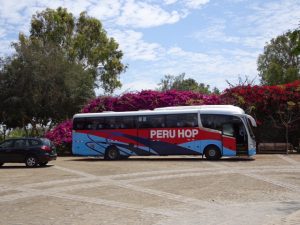 The service makes a couple guided stops along the way. Nice to have some spoon fed history, stories and trivia. Jorge gives us an introduction and turns it over to our guide for the trip, Natalia.
The service makes a couple guided stops along the way. Nice to have some spoon fed history, stories and trivia. Jorge gives us an introduction and turns it over to our guide for the trip, Natalia.
 We make a couple of stops along the way. The first stop is Cristo del Pacifico just outside of Barranca, the hip area of Lima. There are nice views here even with some clouds. We learn a bit here about the Chilean Peruvian war that occurred in the 1880s, much of it seeming to be over territory. The only tensions now are primarily over fútbol and pisco, lol.
We make a couple of stops along the way. The first stop is Cristo del Pacifico just outside of Barranca, the hip area of Lima. There are nice views here even with some clouds. We learn a bit here about the Chilean Peruvian war that occurred in the 1880s, much of it seeming to be over territory. The only tensions now are primarily over fútbol and pisco, lol.
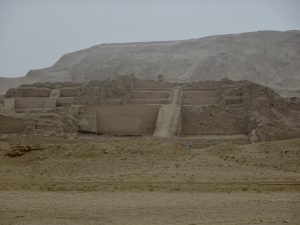 Onward we go to the next stop, Pachacamac, Peru. Here we see a pre-inca temple site from 400 B.C. The temples were built to appease the gods to prevent the earth from shaking. The area around here and Lima sit on tectonic plates with an 8.2 earthquake occurring in 2007, and creating widespread devastation up and down the coast.
Onward we go to the next stop, Pachacamac, Peru. Here we see a pre-inca temple site from 400 B.C. The temples were built to appease the gods to prevent the earth from shaking. The area around here and Lima sit on tectonic plates with an 8.2 earthquake occurring in 2007, and creating widespread devastation up and down the coast.
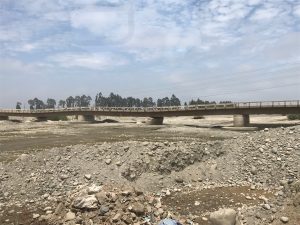 The roads are fine along the way, however, we detour around an interesting bridge. Apparently it is still used when the river is flowing during rainy season!
The roads are fine along the way, however, we detour around an interesting bridge. Apparently it is still used when the river is flowing during rainy season!
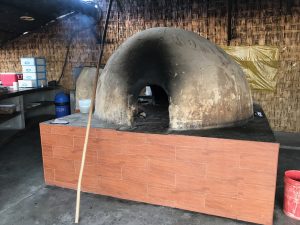
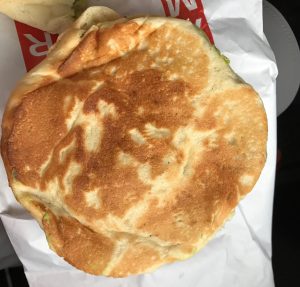 The third stop is for a little brekkie, fresh baked bread at a local place. We have the fresh artisan bread cooked in clay ovens; one stuffed with avocado and one with ham and cheese…delicioso!
The third stop is for a little brekkie, fresh baked bread at a local place. We have the fresh artisan bread cooked in clay ovens; one stuffed with avocado and one with ham and cheese…delicioso!
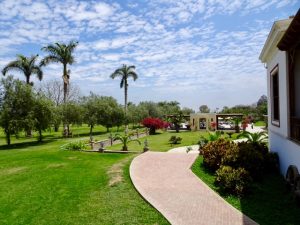
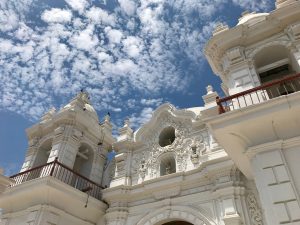 One more stop before Paracas is at Haciendo San Jose. It is here where we see a very large estate of a Spanish family from the 1800s. The estate started with one hundred African slaves with cotton farming and at its peak had over 1,000 slaves.
One more stop before Paracas is at Haciendo San Jose. It is here where we see a very large estate of a Spanish family from the 1800s. The estate started with one hundred African slaves with cotton farming and at its peak had over 1,000 slaves.
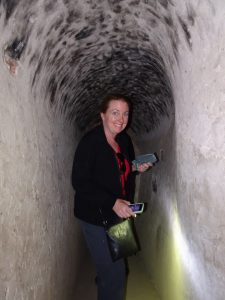 The slaves built slave tunnels for the owners. There are over 17 km of tunnels to protect wealthy owners from thieves and pirates…and to hide, house and transport the slaves. The tunnels led to the Chinca port, so the owner could buy more slaves and avoid taxes. As a result of the African slaves heritage in the area, it is rich with a mixture of Peruvian and African culture.
The slaves built slave tunnels for the owners. There are over 17 km of tunnels to protect wealthy owners from thieves and pirates…and to hide, house and transport the slaves. The tunnels led to the Chinca port, so the owner could buy more slaves and avoid taxes. As a result of the African slaves heritage in the area, it is rich with a mixture of Peruvian and African culture.
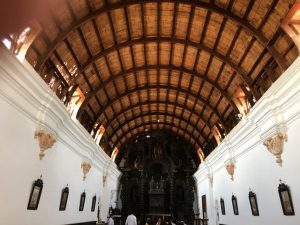
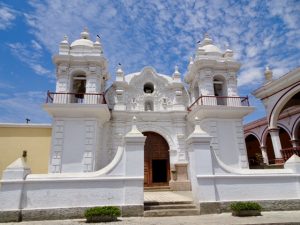 The grounds contain a beautiful church as well. Interesting how these Christian families once condoned the act of slavery of other human beings.
The grounds contain a beautiful church as well. Interesting how these Christian families once condoned the act of slavery of other human beings.
The town of Paracas is next!
We have a good lunch, ceviche and more arroz con mariscos…all delicious. By the time we finish lunch it is 15:30.
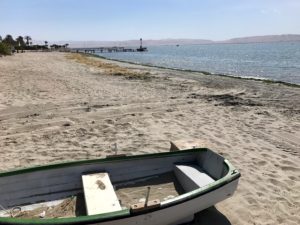
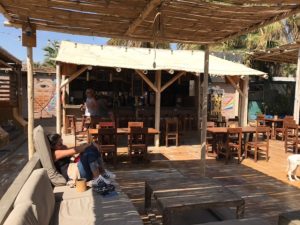 We stroll along the oceanfront and head back to the room. There are not many places to stay in this very small town, nothing luxurious for sure. We are at one of the several hostels, Kokopelli. We have a private room and bath by the pool but away from the bar (there is an all night Latin dance party tonight, which we will not partake in, lol).
We stroll along the oceanfront and head back to the room. There are not many places to stay in this very small town, nothing luxurious for sure. We are at one of the several hostels, Kokopelli. We have a private room and bath by the pool but away from the bar (there is an all night Latin dance party tonight, which we will not partake in, lol).
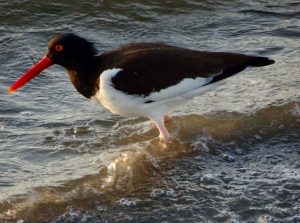
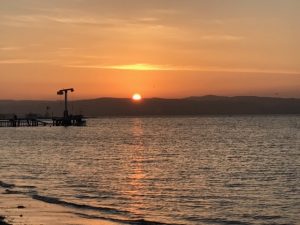 We have just enough time for a quick siesta. The hostel is on the beach so we stroll over to watch the sunset over the nearby mountains. The area has many birds and in particular pelicans. They are mostly the Brown Pelicans which we see in Florida, however, these appear much larger!
We have just enough time for a quick siesta. The hostel is on the beach so we stroll over to watch the sunset over the nearby mountains. The area has many birds and in particular pelicans. They are mostly the Brown Pelicans which we see in Florida, however, these appear much larger!
“When in Rome”
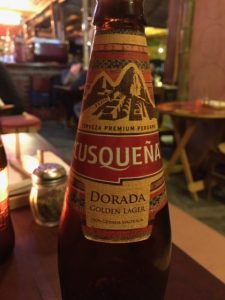
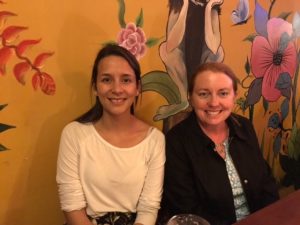 We enjoy a pizza, lol, for dinner with our new amigas Louisa from Columbia. She is a kind, young lady and we enjoy a couple of cold cervezas. We also practice our extensive Spanish, lol.
We enjoy a pizza, lol, for dinner with our new amigas Louisa from Columbia. She is a kind, young lady and we enjoy a couple of cold cervezas. We also practice our extensive Spanish, lol.
Sunday
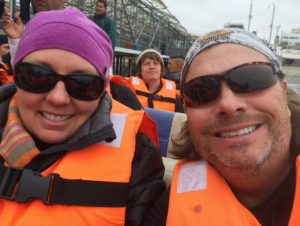 We are up early for our excursion via a short boat ride to the “poor man’s Galápagos”, the Ballestas Islands. The morning is overcast but the views are fine.
We are up early for our excursion via a short boat ride to the “poor man’s Galápagos”, the Ballestas Islands. The morning is overcast but the views are fine.
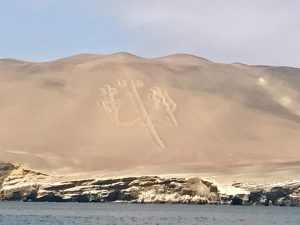 We first pass by an enormous “candelabra” etched into mountainside, the Paracas Candelabra, also called the Candelabra of the Andes. This stunning geoglyph, 800 feet tall, can be found on the northern face of the Paracas Peninsula at Pisco Bay in Peru, and is believed to date to around 200 B.C. It is thought by locals to represent the lightning rod or staff of the god Viracocha, who was worshipped throughout South America. Others have suggested it represents the Holy Trinity while some say it was simply constructed as a navigational sign to sailors as it is visible for up to 12 miles out to sea. Some have even said it is a symbol of the hallucinogenic plant called Jimson weed! Regardless, it is amazing that it has survived this long with the weathering that must occur in the area.
We first pass by an enormous “candelabra” etched into mountainside, the Paracas Candelabra, also called the Candelabra of the Andes. This stunning geoglyph, 800 feet tall, can be found on the northern face of the Paracas Peninsula at Pisco Bay in Peru, and is believed to date to around 200 B.C. It is thought by locals to represent the lightning rod or staff of the god Viracocha, who was worshipped throughout South America. Others have suggested it represents the Holy Trinity while some say it was simply constructed as a navigational sign to sailors as it is visible for up to 12 miles out to sea. Some have even said it is a symbol of the hallucinogenic plant called Jimson weed! Regardless, it is amazing that it has survived this long with the weathering that must occur in the area.
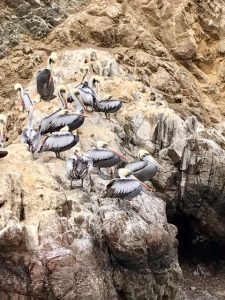
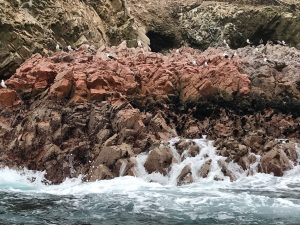 Continuing on about another 20 minutes we reach the Ballestas Islands. They are filled with sea life! Thousands of seabirds, penguins, pelicans, crab, starfish and sea lions! The sea life reminds us a bit of some of the scenery we saw several years ago in Patagonia.
Continuing on about another 20 minutes we reach the Ballestas Islands. They are filled with sea life! Thousands of seabirds, penguins, pelicans, crab, starfish and sea lions! The sea life reminds us a bit of some of the scenery we saw several years ago in Patagonia.
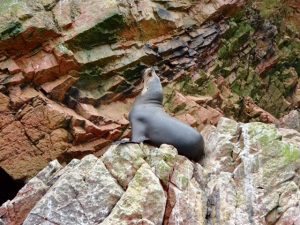 We are able to get very close to the sea lions basking in the morning light. It seems they are posing for us as we approach them, some of them even barking for us.
We are able to get very close to the sea lions basking in the morning light. It seems they are posing for us as we approach them, some of them even barking for us.
We see a few dolphin on the return trip. Also on the return, the sun is coming through the clouds and the sand based mountains are beautiful, also illuminating the candelabra.
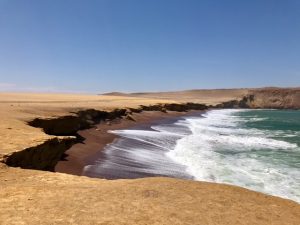
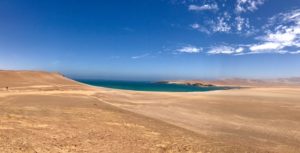 We return to our hostel, gather our belongings, check out and we are on our way to the Paracas National Park. The scenery here is magnificent. It has been shaped over millions of years by the ocean that once covered it, volcanoes, earthquakes, weather and erosion.
We return to our hostel, gather our belongings, check out and we are on our way to the Paracas National Park. The scenery here is magnificent. It has been shaped over millions of years by the ocean that once covered it, volcanoes, earthquakes, weather and erosion.
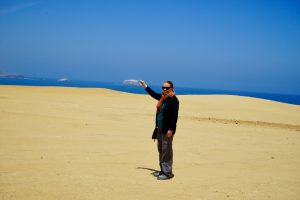
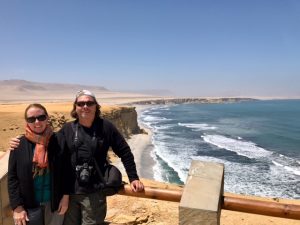 We make three great stops here in the park. The landscapes are stunning, arguably unique in the world.
We make three great stops here in the park. The landscapes are stunning, arguably unique in the world.
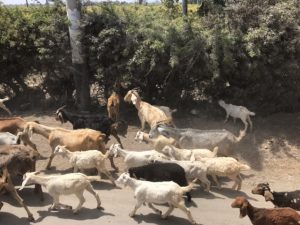 The stay and exploration in Paracas is definitely worth it if in Peru! Off to Huacachina for more adventure!
The stay and exploration in Paracas is definitely worth it if in Peru! Off to Huacachina for more adventure!